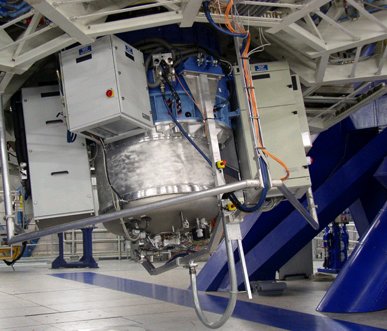Overview
SPIFFI is a near-infrared integral field spectrograph for the ESO VLT. It allows observers to obtain simultaneously spectra of 2048 pixels in a 32x64 pixel field-of-view. In conjunction with the adaptive optics system MACAO - the combination is called SINFONI - it is possible to perform spectroscopy with variable slit widths sampling the diffraction limit of an 8m-class telescope. SPIFFI covers the near-infrared wavelength range from 1.1µm to 2.45µm with a moderate spectral resolving power ranging from R=1500 to R=4000. SPIFFI was operated as a guest instrument at the VLT in 2003, and then re-installed as part of SINFONI in 2004.To preserve its unique capabilities of adaptive optics assisted integral field spectroscopy at the VLT in the long term, the SPIFFI spectrograph will be migrated to the ERIS instrument.
The following picture shows SPIFFI / SINFONI at the VLT UT4 telescope.
Characteristics
- 2048x2048 HAWAI 2RG array increases both spatial and spectral coverage by a factor of 8 over the preceding instrument 3D
- The field of view is sliced into 32 slices
- With a scale changer in the pre-optics the slit width is selectable between 0.25", 0.1" and 0.025"
- Corresponding field-of-view sizes are 8"×8", 3.2"×3.2" and 0.8"×0.8"
- Each one of the 32 slitlets is imaged onto 64 detector pixels.
- Four gratings on a wheel provide spectral resolving powers of R=2000, 3000, 4000, 1500 in J, H, K, and H+K band, respectively, in the largest pixel scale.
- The high spectral resolving power allows one to "suppress" the OH sky-lines to achieve deeper integrations.
- A sky spider facilitates the simultaneous observation of blank sky in one corner of the field of view, allowing long integrations without nodding the telescope
Image Slicer
The heart of SPIFFI is its image slicer, which converts the two-dimensional field of view into a one-dimensional slit. This slit is fed into a long-slit spectrograph to disperse the light of each pixel in the two-dimensional field of view at the same time. During the data reduction the two-dimensional spatial information together with the spectral information is used to create a data cube. The basic concept of image slicing is shown here:
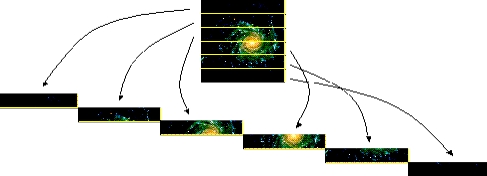
The SPIFFI image slicer consists of two sets of plane mirrors. The first set of mirrors, the "Small Slicer" labeled B in the cartoon below, consists of a stack of 32 mirrors which slice the image into 32 slitlets. The second set of mirrors, the "Big Slicer" or A in the cartoon, rearranges the fan of 32 slitlets to form a pseudo long-slit.
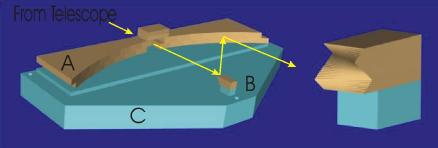
Spectrograph
After the SPIFFI field of view is sliced into a one-dimensional slit, a long-slit spectrograph disperses the light onto a HAWAII detector.
Design
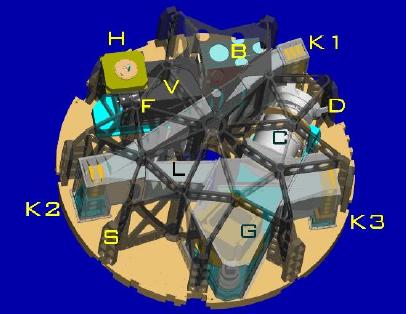
Shown here is an overview perspective of SPIFFI.
| H : Sky spider | F : Filter wheel | V : Pre-optics |
| B : Image slicer | K1-3 : Collimator | G : Grating wheel |
| C : Camera | D : Detector | L : Enclosure |
| S : Enforcing structure |
As built
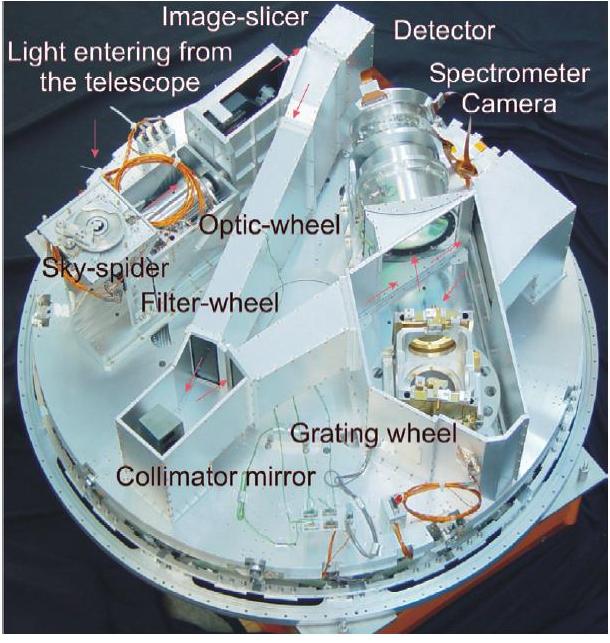
Detector
The detector used in SPIFFI is a Rockwell HAWAII Focal Plane Array with 20482detector elements.
Control Electronics
The control electronics of SPIFFI is based on the ESO control scheme developed for VLT instruments. An HP workstation runs the graphical user interface for controlling the instrument and the detector and for displaying the data. A VME-bus-based real-time computer actually controls motorized functions and reads sensor and status signals. A SUN workstation in conjunction with an ESO IRACE controller collects the data from the detector.
Team (in alphabetic order)
- Roberto Abuter
- Klaus Bickert
- Frank Eisenhauer (Principal Investigator)
- Andrea Gilbert
- Armin Goldbrunner
- Matthew Horrobin
- Stefan Huber
- Christof Iserlohe
- Werner Lieb
- Claudia Röhrle
- Alexander Schegerer
- Jürgen Schreiber
- Matthias Tecza
- Niranjan Thatte
